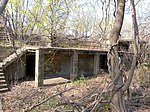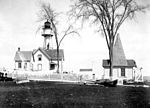Fort Totten Officers' Club
Clubhouses in Queens, New YorkClubhouses on the National Register of Historic Places in New York CityGothic Revival architecture in New York CityInfrastructure completed in 1887Military facilities on the National Register of Historic Places in New York City ... and 5 more
Military officers' clubsNational Register of Historic Places in Queens, New YorkNew York City Designated Landmarks in Queens, New YorkQueens, New York building and structure stubsQueens County, New York Registered Historic Place stubs

Fort Totten Officers' Club, also known as the Castle, is a historic clubhouse located at Fort Totten in Bayside, Queens, New York. The officers' club was built in the 1870s and expanded to its present size in 1887. It is a large Late Gothic Revival style building. It is a two-story, rectangular frame building with a projecting central tower pavilion and sheathed in clapboard. It features identical, polygonal, three story towers and a wood parapet surrounding the roofline.It was listed on the National Register of Historic Places in 1986.
Excerpt from the Wikipedia article Fort Totten Officers' Club (License: CC BY-SA 3.0, Authors, Images).Fort Totten Officers' Club
Officers Drive, New York Queens County
Geographical coordinates (GPS) Address Nearby Places Show on map
Geographical coordinates (GPS)
| Latitude | Longitude |
|---|---|
| N 40.792222222222 ° | E -73.778055555556 ° |
Address
Officers Drive
Officers Drive
11359 New York, Queens County
New York, United States
Open on Google Maps






